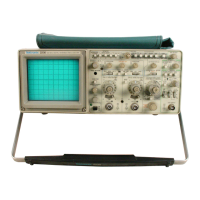Options—2230 Service
Menus are displayed with as much of the selection path
visible as possible. This method displays the current loca
tion in the menu as well as the available alternatives and
messages on how to make a selection.
The COMM Menu:
The COMM menu resides under the ADVANCED
FUNCTIONS menu:
ADVANCED FUNCTIONS
REFERENCE
COMM
ACQ MODE SETUP TREE
DIAGNOSTICS
Once COMM is selected, its submenus appear:
COMM
DATA
STOP BITS (Option 12 only)
FLOW (Option 12 only)
If DATA is selected, its functions appear:
DATA
ENCDG
SOURCE
TARGET
CHANNEL
The ENCDG function selects waveform encoding for
transmission and expected encoding for waveform recep
tion. At power-up, the default encoding is binary. Make
one of three choices from the menu:
ENCDG
ASCII
BINARY
HEX
The SOURCE function selects whether one of the
Reference Memories or the current acquisition is the
source for waveform transfers. If REF is selected, use the
Cursor knob to select the actual reference. REF4 is an
explicit 4K reference:
SOURCE
REF
ACQ
The TARGET function is nearly identical to the
SOURCE function. The only difference is that ACQ is not
a valid TARGET. The TARGET reference is the destination
for all waveforms sent to the instrument:
TARGET
REF
Like SOURCE, waveform TARGET references are
selected with the Cursor knob.
The CHANNEL function selects the channel whose
waveform is sent. With the exception of XY waveforms,
only data from one channel is sent at a time, even if both
channels were acquired in ALT or CHOP Vertical Mode:
CHANNEL
CHI
CH2
The STOP BITS function, available ONLY on Option 12
(RS-232-C), sets the number of stop bits. Use the Cursor
knob to select.
The FLOW function, available ONLY on Option 12 (RS-
232-C), enables or disables Control-S/Control-Q handshak
ing. FLOW must be OFF during binary waveforrn transfers.
FLOW
ON
OFF
GPIB PARAMETER SELECTION
Selection of GPIB parameters (primary address, mes
sage terminator, and talk/listen mode) can be made at any
time using the GPIB PARAMETERS switch and Table 7-6.
Primary Address
The selected GPIB address establishes both the pri
mary talk and listen addresses for the oscilloscope. It can
be set to any value between 0 and 31, inclusive.
NOTE
This instrument has no provisions for secondary
addressing as defined by ANSI/IEEE Std 488-1978.
With an address of 31, the instrument still presents an
active load but does not respond to nor interfere with any
bus traffic. This is useful for changing the instrument’s
status without turning off the oscilloscope’s power.
Input End-of-Message Terminator
The end-of-message terminator can be selected to be
either the End-or-ldentify (EOI) interface signal or the
Line-Feed (LF) character.
7-9

